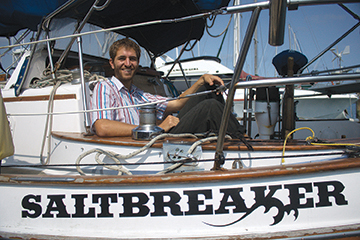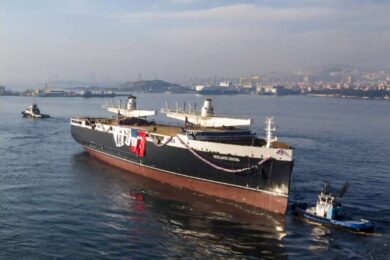Working while cruising, can the two mix? (published October 2014)
Sounds good, doesn’t it: working as you cruise around the globe. Many sailors fantasize about such an arrangement, but just how viable is it to work while you cruise? What are the risks and the limitations? What are the rewards?
Many sailors really do manage to combine work and pleasure, financing their dreams in whole or in part by working as they go. Some are self-employed, working opportunistically as they sail. Others use modern technology to communicate with an employer or business back home. But working afloat has its headaches and compromises, just as real-life cruising does. The responsibilities of work can impact cruising plans and place considerable demands on fellow crew. Working requires self-discipline, organization, and in some cases, considerable investment. Sometimes, the freedom of cruising is sacrificed in favor of the job. On the other hand, the income earned allows sailors to stretch their time out cruising by seasons or even years. Many working cruisers report that their occupations also enrich their overall experience— connecting them to communities, helping others and keeping their professional skills sharp.
What types of work are compatible with cruising? All kinds, it seems. There are writers, financial planners, and graphic artists, musicians, management consultants and resourceful jacks-of-all-trades. I spoke with a number of working sailors who shared their insights, advice and warnings so that others thinking of following their lead may do so with a realistic frame of reference.
Helena Traksel of Merilelu, a 1998 Dehler 40, may well have one of the more glamorous-sounding jobs afloat. The Dutch sailor left behind a career in architecture to turn her SCUBA diving hobby into a means to bring in cash while cruising the world. But it’s not all play under the sea. In fact, hers is a demanding job that requires the full partnership of her husband, Kari, who prepares gear, fills tanks and stands by each dive. “He does as many hours as I do,” Helena says. By teaching an average of four students a month, their combined efforts bring in enough cash to pay about a quarter of their modest cruising expenses. However, it’s a high-investment profession when one considers the costs of PADI instructor training (upwards of $2,000) and equipment (including a compressor and four sets of SCUBA gear, which in turn require copious amounts of fuel and fresh water, not to mention precious space). The rewards of the working-cruising lifestyle, on the other hand, are many. “An architect is about stress, being in an office. I’m blessed with two good professions, and opposite ones,” says Helena.
Helena‘s choice of work was carefully planned. “I had been sailing before and I saw the market—almost a need—in remote places like the Marquesas.” She keeps her “business” small, using word-of-mouth advertising among fellow cruisers. In fact, she could work and earn more, but the Dutch diver strives to maintain a balance: “The idea is to see the world and work on the side, and not the opposite.”
Dive instruction is a good example of a job that doesn’t usually restrict one’s cruising schedule, since interesting anchorages and good diving often have much in common. Helena has taught fellow cruisers in some of the world’s most remote and pristine dive locations, such as the lesser-known Tuamotus or the Cook Island atoll of Suwarrow. Not a bad arrangement!
 Not everyone plans to work and sail. For some, opportunity knocks and they don’t turn a deaf ear. Alex Kleeman of Saltbreaker, a 1979 Valliant 32, was ready to quit his job as a programmer to go sailing, but his San Francisco-based company just wasn’t quite ready to let him go. Instead, they asked Alex to take on smaller, less urgent projects that could be worked on independently.
Not everyone plans to work and sail. For some, opportunity knocks and they don’t turn a deaf ear. Alex Kleeman of Saltbreaker, a 1979 Valliant 32, was ready to quit his job as a programmer to go sailing, but his San Francisco-based company just wasn’t quite ready to let him go. Instead, they asked Alex to take on smaller, less urgent projects that could be worked on independently.
After leaving California in September, 2011, the sailor worked roughly ten hours a week on the way south through Central America, cutting back while crossing the Pacific. As Alex says, “The opportunities I kept seeing around me seemed to trump work a lot. When the boat is floating over an impressive coral reef, you just have to go snorkeling!”
Once in New Zealand, however, he went back to thirty hours a week to top up the cruising kitty. “If I didn’t work on the way over, I probably would have been flat broke when I showed up in New Zealand. With the work, I came out a little bit ahead. I kept thinking of it like bonus money. At this point (in New Zealand), it’s very much replenishing.”
In Alex’s case, working remotely requires only a laptop and the occasional Internet connection. Though Alex admits that he got lucky with his work situation, it’s important to note that his “luck” might have turned out differently had he not established a solid, long-time working relationship with his company, proving his abilities and reliability. He advises others seeking a similar arrangement to be flexible, accepting a pay cut or less interesting projects in exchange for the freedom they gain.
While Alex generally finds that work is compatible with cruising, he adds, “there are definitely times when I could not work: on passage or underway, unless it’s really calm. Like, not moving!” He adds, “I can think all day and formulate what I want, but in the end I need to set aside a chunk of time to get it done.”

Internet access is another restriction, but Alex found that he could work around that by preparing a queue of tasks to tick off when the opportunity arose. On the whole, he says, “cruising and working tends to imply you’re going slowly or spending more time in each place.” As in everything with sailing, flexibility is key.
Like Alex, a number of working cruisers maintain some ties to their former employers, such as Robert DeLong of Cricket, a 1967 Alberg 37. Periodically throughout his trip from British Columbia to Panama, the mechanic would fly home for a few months of work, then pick up where he left off. Once word spread through the cruising fleet that there was a qualified marine diesel mechanic in their midst, he was able to work exclusively from his boat. Enough that if he wanted to, Robert could cover all of his cruising expenses (approximately $500 a month). But like other working cruisers, Robert limits his working hours to better enjoy the locations he visits. For him, the income allows luxuries such as restaurant meals and moorings that his modest budget wouldn’t normally permit.
Surprisingly, his line of work is light on equipment. Since different engines require different tools, he relies heavily on the boat owner’s tools along with his own basic kit. On the other hand, the work calls for a highly specialized skill set. Robert is an experienced marine diesel mechanic, not “just” a general repairman. “Time and time again, I’m repairing things that are done by ‘professionals.’ Boat engines are amazingly complicated systems and very unforgiving,” Robert warns. His qualifications are one reason he is in such high demand. Another is his generous approach. “For every hour I can charge, I spend two to three hours giving free advice,” he admits. But, as he says, “it’s my community and I’m helping them out.”
Work often impacts Robert’s cruising schedule. “It affects my freedom because you make commitments. There’s been a couple of times when I’ve stayed behind because I had another two to three days of work to finish. You’re suddenly responsible for two boats making their weather window.” On the other hand, because he often stays longer in one place, Robert finds that he gets to know the local scene better than many cruisers who breeze through more quickly.
Because Robert is a singlehander, work provides a social avenue. He enjoys meeting other sailors and encouraging them to do their own repairs. In doing so, he says, “I’m helping somebody become more proficient at living their dream.” The satisfaction this brings has become an important aspect of Robert’s cruising experience. Like Helena, the SCUBA instructor, Robert is careful not to tread on the toes of local business people. Much of the work he does is in out of the way places. Just try calling a mechanic in to Fatu Hiva or Minerva Reef! His advice to others? “If you want to make a living making your way across the Pacific, develop a skill in electronics (radar, autopilots, AIS) because no one has it!”
Another way of earning money is to use your sailing skills as a means to finance adventures afloat. When Maine-based sailors Bob and Maggie Daigle returned from a world circumnavigation aboard a friend’s yacht, they weren’t ready to swallow the hook. Instead of returning to their careers, they moved into charter work, a step facilitated by the contacts they made during their circumnavigation. Now, the licensed captains run a privately owned charter catamaran in the Virgin Islands. However, the couple agrees that “it is a totally different mindset from cruising,” more work than play.
This line of work requires multiple certifications, from United States and B.V.I.-recognized captain’s licenses to special endorsements required to operate a charter yacht. And there’s no underestimating the amount of work involved, Bob reports. “Both of us agree we´ve never worked quite so hard before. During the charter we are literally on from 6 a.m. until 9 p.m.—with half an eye open in the night as well. The boat is heavily used, so we have probably 10 to 15 items to fix, replace or install during our 24 hours between the end of one charter and the beginning of the next. This job may seem glamorous, but I don´t think I have a T-shirt left that isn´t free of oil stains!” Their schedule is centered around guest bookings, which usually prevent family visits during holiday periods.
So why bother? For one thing, it allows the couple to do what they love in a beautiful region, in addition to making interesting new acquaintances—even lifelong friendships—with guests, many of whom have become regulars. The couple enjoys working as a team, too. “This crewed charter business is taking full advantage of each of our skill sets and stretching both of us continually to learn new things,” Bob explains. One perk is the eight-month-on/four-month-off schedule, which allows the couple to relax and recuperate during the summer.
Another positive is that charter crews essentially pocket all their earnings (a 50-50 mix of tips and payment per charter from the boat owner), since their expenses during the season are virtually nothing. It did take a season for the Daigles to establish themselves in the business, but since then, bookings have kept this crew bustling.
But the job is not for everyone, Maggie cautions. “This is definitely not a job for a couple who wants to ‘live the dream’ for the first time.” Bob suggests that sailors “take a year or two and go cruising to make sure you really like this lifestyle. After confirming this, you can introduce guests into the picture.” That said, the couple positively glows with satisfaction at their overall work “package.” All in all, working as professional crew is an enticing prospect for those with the right resolve and qualifications, and doesn’t necessarily require boat ownership.

Full-time cruising provides an abundance of time and inspiration, a perfect foundation for aspiring writers. Some sailor-authors write for periodicals; others pen entire books, from novels to non-fiction. For most, writing is an enjoyable hobby that brings in the occasional bonus rather than a means of underwriting the lifestyle. Personally, writing helps cement vivid impressions in my mind, as well as inspiring me to observe people, places and situations more closely than I might otherwise have. It’s a low-investment, flexible line of work that puts few demands on fellow crew and rarely impacts cruising plans. However, like many other working cruisers report, it can be difficult to get a lot accomplished when the boat is in motion. Most writers carve out quiet time at anchor to further their literary aspirations. This, in turn, makes it a challenge to balance the amount of time devoted to “work” with time spent enjoying the surroundings, a conundrum faced by all working cruisers.

Given the vast range of possibilities in working while cruising, what are the commonalities? All the working cruisers I spoke with have mastered valuable skill sets; they are flexible, disciplined people, and they cruise on modest budgets. For most, hitting their stride in terms of work took some time. Finally, most agree that it can be difficult to use time underway productively. Rather, it is down time that falls victim to work. Like everything else about sailing, there are compromises to be made, though the parameters are largely of one’s own making.
Is working while cruising for you? With reasonable qualifications and modest expectations, it certainly is worth a try. Ultimately, most cruisers who work agree that their efforts pay off—and not just in the monetary sense.
Nadine Slavinski is the author of Lesson Plans Ahoy: Hands-On Learning for Sailing Children and Home Schooling Sailors. Together with her husband and young son, she cruised the Atlantic and Pacific aboard her 1981 Dufour 35, Namani. She is currently at work on The Silver Spider, a novel of sailing and suspense, as well as Pacific Crossing Notes: A Sailor’s Guide to the Coconut Milk Run (see nslavinski.com for more information and free resources on home schooling).

















